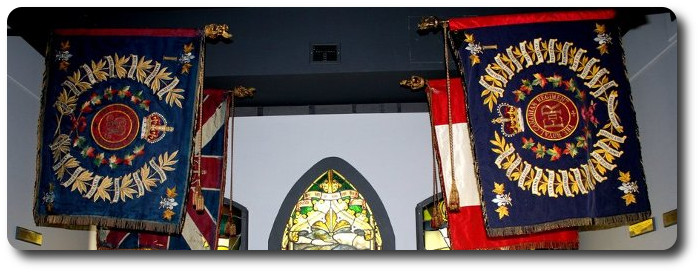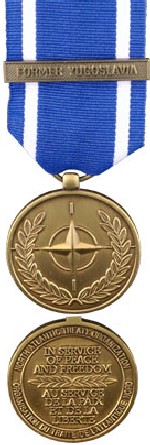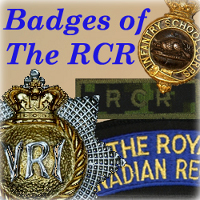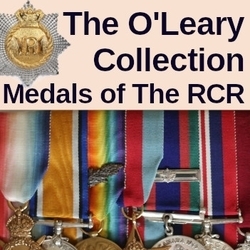
Researching The Royal Canadian Regiment
Golf Company Surge Operations
Major Bill Pond
Pro Patria, Issue No. 81, January 2000

NATO Medal for Former Yugoslavia (NATO-FY) is awarded for thirty days continuous or accumulated service in direct support of NATO operations, on land, at sea or in the air spaces of the Former Yugoslavia, Albania, the Former Republic of Macedonia, and the Adriatic Sea (the theatre of operations) commencing 1 July 1992 and ending 31 December 2002
During Operation PALLADIUM Roto 4, Golf Company participated in a number of operations in support of Multi National Division {Southwest). Among the most popular and interesting of these were what are known as surge operations. As the name implies, these saw sub-units of the various contingents within MND (SW) move into another Area of Operations (AO) to support the in-place force. These could be conducted for a number of reasons such as reinforcement, facilitation of regrouping/ redeployment of in-place assets, or as a show of force/re-assurance mission. They also allowed the Division units to practice and, if necessary, polish procedures for inter-operability within a diverse theatre of operation.
G Coy's initial surge operation ran from 28 Mar-3 Apr 99 and consisted primarily of a Divisional Reserve role, which saw elements of the Coy HQ and 3 Platoon complete deploy into Camp Maple Leaf in Zgon (home of the men of H Coy). Our task was to be prepared to rapidly surge into the Czech AO near the towns of Ljublia, Sanski Most, and Prijedor. The mission was to fix elements of the VRS (Army of the Republika Srpska) in their cantonment sites (using TOW Under Armour) to patrol some key lateral routes, and to demonstrate SFOR resolve and capability to maintain the peace during the uncertain first days of the NATO intervention in Kosovo. Extensive liaison and reconnaissance was conducted with 3 Czech Mechanized Bn (3 Czech Mech). By early April, it was evident that the VRS forces would remain compliant, and the operation was stood down. However, H Coy was involved in a surge southward in support of the UK Battle Group to their south. So 3 Platoon conducted a relief in place, occupying the Bosanski Petrovac Platoon House from 4-25 April inclusive.
The Czech sector had not seen the last of the men of G Coy. 1 Platoon was forward deployed into the Sanski Most area to conduct reassurance patrolling with N Bty 3RHA (who were OPCON 3 Czech Mech) from 6-10 April. Round the clock vehicle and dismounted patrols of some fairly contentious areas were the order of the day. 1 Platoon had a chance to put their earlier recces to good use when they surged into the Kozarac area for another round of patrolling from 1921 May.
Surging is a two way street. The 3 Czech Mech conducted a coy size surge into the G Coy AO, concentrating their efforts on dismounted patrols into Buzim and environs on 14 and 15 May.
Our experiences with and impressions of the Czech Army were uniformly positive. Language was more of an inconvenience rather than a barrier, with many of their younger officers, NCOs and junior ranks speaking English quite well. Our new NATO partners bring much to the table, and although they are very much an army in transition, they have already proven to be extremely professional, well equipped, and eager to become a full partner in alliance operations.
June saw unquestionably the most popular of the surge operations. Op CARBON 14 saw G Coy pre-positioning vehicles in the Dutch AO and then flying platoons in and out via RAP Chinooks, conducting 24 hr patrol sessions over a four-day period (11-14 Jun incl). Our hosts for this period were 12 Inf Bn Regiment Van Heutz (12 RvH). Normally based near Amhem, 12 RvH is an airmobile battalion that re-roled into Mech Inf for SFOR duties. Since professionalizing in the early 90s, the Royal Dutch Army of today bears scant resemblance to the force many Royal Canadians will recall from NATO duty in West Germany. 12 RvH considers itself to be the spearhead of the Dutch rapid reaction forces, and concensus amongst the men of G Coy is that this is no idle boast. They were a pleasure to work with, and proved their mettle during what could have been a tragic incident. During a morning patrol on Sunday 13 June, an AVGP, in the company of a Dutch Mercedes Light Patrol Vehicle, struck a hidden tree root on a mountain switchback. The driver, Pte Craft, gave warning to the crew to brace themselves before the vehicle began rolling down a steep embankment. It came to rest some 85 metres later in a creek bank. The 12 RvH response was immediate. The four injured Royal Canadians were evacuated, under the watchful eye of the Dutch Medical Officer, by British helicopter to a German medical facility where they were held for 24 hrs for observation (thankfully all escaped with only minor injuries). The AVGP was less fortunate; our Dutch comrades assisted the EME MRT in a very difficult recovery for subsequent backloading to the Canadian Echelon for repairs.
The surge operations were extremely popular with all ranks - the opportunity to work with the other contingents of our parent Division allowed us to learn more about our coalition partners; and them to see us doing what Royal Canadians do better than most: soldier and soldier well. The adage "2nd Battalion – Second to None" is now a watchword throughout MND (SW), as it should be.



